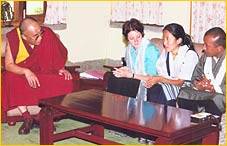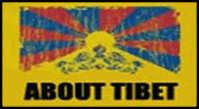


"I have met with the young participants of the project and encouraged with what they have achieved so far. I fully support the work of TJYE and would like to appeal to others to do so."
His Holiness, The 14th Dalai Lama, 8 June 2001
The background
In 1999, Kalela Lancaster, a young Jewish woman from London, UK visited Dharamsala. She involved herself in the community as a volunteer for a few months. When she participated in a seven day peace march to commemorate the Tibetan uprising in 1959, she saw how transformed these young people were when they had an outlet for their passion, for their country and their identity and how eager they were to take on leadership roles. Her experience not only moved her deeply, but also reminded her of the powerful atmosphere created at the Jewish summer camps she had attended as a teenager in the Orthodox Zionist youth movement Bnei Akiva. The idea suddenly came to her, maybe she could give the young Tibetans a chance to come and see the youth movement structures that exist in the Jewish community; some kind of exchange. Though some of the `secrets' of Jewish survival are not transferable, like Shabbat, kashrut (Jewish dietary laws) and other religious rituals, but the educational aspect is. Lancaster is not the first to draw links between Tibetan and Jewish experiences. Back in 1990, a group of mostly American Jews met with the Dalai Lama, the Tibetan political and spiritual leader, who called on them to share the secret of Jewish survival in exile.
The project …
Kalela took proposal to the Secretary, Dept of education, CTA - who had previously visited Jewish schools in the United States following an invitation from writer Blu Greenberg, who had been part of the 1990 delegation and straight away issued a letter of endorsement. On her return to the UK, Lancaster found support for the idea of an exchange, Based in London, she set about forming a committee called Tibetan Jewish Youth Exchange (TJYE) to pursue the idea - which drew several graduates of Zionist youth movements - and brought in members of the 300-strong Tibetan community in the UK. She also secured funding from the UK Jewish Aid and International Development charity and the Tibet Relief Fund to pay for a return trip to Dharamsala to pilot some activities.
The birth of Longsho ...
Back in India, Lancaster sought to try out informal education techniques with a group of Tibetans, some of whom would later become youth leaders. Together, they built an educational program with themes of tradition and modernity, interdependence and the five principles of Buddhist ideology, which they ran for pupils from a local Tibetan school (which teaches partly in English). Next, when four British youth leaders, including Lancaster, traveled to India to help run the first residential summer camp, they were invited along with the Longsho youth leaders to meet with the Dalai Lama, where they received his blessing for the project. His Holiness said
I am happy with the TJYE project for two reasons: firstly I have always believed that the Tibetans can learn from the experience of over two thousand years of Jewish Diaspora. Secondly exchange program of this kind are always useful in creating exposure for the Tibetan youths and an opportunity to learn new skills. Both these are important to the Tibetan people particularly at this very critical time of our history. I fully support the work of TJYE and would like to appeal others to do the same.
Thus with blessing from His Holiness on 8th of June 2001, longsho came into birth and celebrate the days as its foundation day.The first exchange programme
In summer 2001, the Summer Training Exchange Programme was established, planned and organised. Four Tibetan youth leaders, the founders of this project, Kalsang Dorjee, Namgyal,Sonam Dechen, Nyima Wangmo were sent to the UK to experience a six-week intensive informal education training programme and to participate in three Jewish summer camps. The programme was a massive success. The Tibetan youth leaders gained new skills and understanding as well as a lot of new friends and support for the project. On their return, they organize residential camps by themselves and since then, every year Longsho run two residential camps in summer and winter. The story of Longsho then begins….












Web designed and developed by: Tenzin Sherab (Longsho leader) with funding from National Endownment for Democracy (NED)